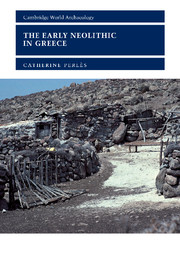Book contents
- Frontmatter
- Contents
- List of figures
- List of tables
- Acknowledgements
- Introduction
- 1 The land and its resources: the geographic context
- 2 The Mesolithic background
- 3 The introduction of farming: local processes, diffusion or colonization?
- 4 Foreign colonists: where from?
- 5 The earliest Neolithic deposits: ‘aceramic’, ‘pre-pottery’ or ‘ceramic’?
- 6 The spread of the Early Neolithic in Greece: chronological and geographical aspects
- 7 A case study in Early Neolithic settlement patterns: eastern Thessaly
- 8 Early Neolithic subsistence economy: the domestic and the wild
- 9 The Early Neolithic village
- 10 Craft specialization: the contrasting cases of chipped-stone tools, pottery and ornaments
- 11 A variety of daily crafts
- 12 Ritual interaction? The miniature world of ‘dolls or deities’
- 13 Interacting with the dead: from the disposal of the body to funerary rituals
- 14 Interactions among the living
- Conclusion
- Bibliography
- Index
2 - The Mesolithic background
Published online by Cambridge University Press: 18 December 2009
- Frontmatter
- Contents
- List of figures
- List of tables
- Acknowledgements
- Introduction
- 1 The land and its resources: the geographic context
- 2 The Mesolithic background
- 3 The introduction of farming: local processes, diffusion or colonization?
- 4 Foreign colonists: where from?
- 5 The earliest Neolithic deposits: ‘aceramic’, ‘pre-pottery’ or ‘ceramic’?
- 6 The spread of the Early Neolithic in Greece: chronological and geographical aspects
- 7 A case study in Early Neolithic settlement patterns: eastern Thessaly
- 8 Early Neolithic subsistence economy: the domestic and the wild
- 9 The Early Neolithic village
- 10 Craft specialization: the contrasting cases of chipped-stone tools, pottery and ornaments
- 11 A variety of daily crafts
- 12 Ritual interaction? The miniature world of ‘dolls or deities’
- 13 Interacting with the dead: from the disposal of the body to funerary rituals
- 14 Interactions among the living
- Conclusion
- Bibliography
- Index
Summary
An elusive Mesolithic: absence of evidence or evidence of absence?
Here, I shall use the term Mesolithic in its chronological sense, to designate early Holocene hunter-gatherer assemblages. The period under consideration spans between c. 9500 and 8000 BP uncalibrated, or c. 8700 to 7000 BC in calendar years. Detailed data-oriented presentations have been offered elsewhere (Perlès 1990a, 1995; Runnels 1995), so I shall focus on issues directly relevant to the problem of the origins of the Neolithic.
The most salient characteristic of the Mesolithic in Greece is how poorly it is known, and how few sites are recorded. Diverging opinions about the significance of this scarcity have led to opposing views on the origins of the Neolithic in Greece. I shall argue that Mesolithic Greece was indeed sparsely populated, and that this low demography rules out the hypothesis of a purely indigenous shift to agriculture.
The few sites known to date concentrate in two main regions: north-east Attica and the Argolid, in eastern Greece, Corfu, the coastal plains of the Acheron and the Preveza region in north-western Greece (fig. 2.1). So far, only four sites have been excavated and published: Sidari in Corfu, Franchthi in the southern Argolid, Zaïmis in Attica and Ulbrich also in the Argolid. The important site of Theopetra, in Thessaly, with a sequence spanning the Palaeolithic, Mesolithic and Neolithic, is currently under excavation by N. Kyparissi-Apostolika.
- Type
- Chapter
- Information
- The Early Neolithic in GreeceThe First Farming Communities in Europe, pp. 20 - 37Publisher: Cambridge University PressPrint publication year: 2001



